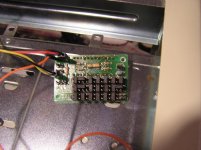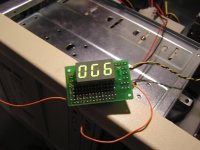Wow, that is crazy, I can't even get my display to turn on pinned like that. Not sure how yours is working...on the top left row, the last two pins labeled "5V and G," I believe is supposed to be for the power cable. Yours has the red wire going to 5V, which makes sense, but the black going to the ground on the left, which according to the brackets on the circuit board looks like its intended to be for the ground for the signal wire coming from the motherboard's turbo LED (there is no ground wire for that, however, not needed). My display won't turn on if I wire it like yours. But hey, if it works, don't mess with it.
And the turbo light won't come on in mine wired like you have yours; however, it will come on and stay lit if I wire it to "+P" and "-P" (fourth row of pins down on the left). I can't get it to switch off though.
The turbo switch is functioning, but I still can't get the display to change. It's weird though -- I run MAXSPEED with turbo on and it says it's going at 64mhz. Turn if off and it only clocks down to around 52. I haven't tried any other programs to see if they say something different.
Funny thing is, when I first got the machine, pressing turbo would change the display from 66 to some nonsensical number, but not consistently. However, now after messing around I can't get it to change at all, even going back to the way it was. I've tried every possible jumper combination, but there only appears to be one jumper setting (vertical, every other jumper shorted) that causes an LED segment to light. The first two rows are for the 3rd digit (the ones), the second two rows for the middle digit (the tens) and the third two rows for the first digit (the hundreds). On yours, no pins on the last two rows are jumpered (because your display is just 66, no first digit). Mine is jumpered to display 066. But for the life of me I cannot get it to change when turbo is pressed.
Sorry for the rambling post. This thing has bugged me for days whenever I get a chance to mess with it. I know it's not really important, but I would like to solve the puzzle. But I'll just be content with 66 displaying all the time and the turbo button always being lit. If I want slower, I still have a 386!


